Opinion Mining and Sentiment Analysis in Marketing Communications: A Science Mapping Analysis in Web of Science (1998–2018)
Abstract
:1. Introduction
- How has scientific research at OMSAMC progressed from 1998 to 2018?
- In which countries and organizations has most of the research on OMSAMC been carried out?
- What are the main sources of publication (journals) that publish research on OMSAMC?
- Who are the most productive and cited authors in OMSAMC research during the study period?
- What is the degree of international scientific collaboration in OMSAMC research?
- What type of authoring patterns are observed in the results of OMSAMC research?
- What are the main concepts that appear in OMSAMC research publications?
- What are the main themes, approaches and methods of OMSAMC?
- What are the main areas of application of OMSAMC research?
2. Results
2.1. Distribution of Documents by Year (1998–2018)
2.2. Citation Report
2.3. Top 25 Co-Authorship Analysis (Authors and Record Count)
2.4. Group Authors and Record Count
2.5. Top 25 Co-Authorship Analysis (Countries/Regions and Record Count)
2.6. Top 25 Co-Authorship Analysis (Organizations and Record Count)
2.7. Top 25 OMSAMC Funding Agencies and Top 25 InCites Funding Agencies and Record Count
2.8. Research Areas and Record Count
2.9. Top 25 Co-Citation Analysis (Sources)
2.10. Co-Occurrence Analysis
- Cluster 1 Social Media, Machine Learning and Artificial Intelligence: algorithms, antecedents, behavior analysis, big data, blogosphere, brand monitoring, business intelligence, classification, cluster analysis, clustering, community, deep neural networks, emotions, engagement, eye tracking technology, face recognition, Facebook, framework, identification, image, image classification, in-game advertising, influence, information technology, Instagram, intelligence, k-means, literature review, marketing intelligence, models, naive Bayes, network, object detection, opinion, pattern recognition, power, retrieval, satisfaction, sentiment, small business, social influence, social media, social media analytics, social media mining, social media monitoring, social network, social network analysis, support vector machines, systems, technology, text classification, tourism, trust, twitter, visual analytics, visualization, words.
- Cluster 2 Product Design: advertisement, advertising, alcohol, allocation, avoidance, behavior, bias, body dissatisfaction, brand recall, brands, commercials, communication, consumption, drivers, experience, exposure, eye, eye fixation, eye movement, eye tracking, health, health warnings, interactivity, labels, media, messages, nonsmokers, online, patterns, perceptions, perspective, pictorial, pictures, products, recall, road safety, smokers, television, smoking, text, tobacco, trends, tv, united states, video, visual attention, warning labels, working memory.
- Cluster 3 Design Techniques: advertisement, algorithm, attitudes, augmented reality, color, computer vision, customer satisfaction, design, digital image processing, food, gender, grading, hidden Markov model, image processing, image segmentation, integration, knowledge, machine, machine vision, methodology, model, neural network, objects, optimization, orange, prediction, purchase intention, quality, regression, segmentation, sex differences, sorting, support vector machines, surface area, system, user experience, vision, website.
- Cluster 4 Advertising and Message Impact: ads, animation, attention, attitude, capacity, capture, children, cognitive load, context, contextual advertising, distraction, features, human-computer interaction, information, internet, internet use, involvement, looking, mechanisms, motion, movement, older drivers, online advertising, people, performance, persuasion, saliency, search, selective attention, strategies, surveillance, tracking, visual attention, visual behavior, visual saliency, visual search, web design, websites, world wide web.
- Cluster 5 Advertising and Neuroscience: advertising effectiveness, affective computing, arousal, biometrics, brain, consumer, cortex, cues, destination, digital signage, EEG, emotion recognition, face, familiarity, feature extraction, galvanic skin response, gaze, gender classification, images, interferences, memory, object recognition, perception, preference, recognition, representation, responses, scale, scenes, selection, stimuli, television commercials, valence, warnings, young.
- Cluster 6 Social Network Analysis (SNA): approximation, artificial intelligence, convolutional neural networks, corpus, cross domain, customer reviews, data mining, deep learning, e-commerce, emotion analysis, feature selection, image recognition, information extraction, lexicon based, machine learning, marketing, natural language processing, networks, neural networks, NLP, ontology, opinion mining, product review, security, semantic web, sentiment analysis, sentiment classification, text analysis, text categorization, topic modelling, tweets, web, word embedding.
- Cluster 7 Consumer behavior: analytics, brand image, communities, community detection, congruity, consumer reviews, dynamics, experience, field, helpfulness, hospitality impact, knowledge discovery, lexicon, management, moderating role, news, online products review, online reputation management, online reviews, persuasion knowledge, product, reputation, saccades, sales, semantics, sentiments, social media marketing, support, text mining, user-generated content, word of mouth.
- Cluster 8 Brand Analysis and Retail: brand, brand attention, brand choice, branding, choice, consumer behavior, consumer choice, consumer neuroscience, decision making, display, eye tracking, eye movement, facial expression, fixations, gaze bias, implicit memory, in-store decision making, mere exposure, neuromarketing, nutrition information, print advertisement, promotion, selective visual attention, time, time-pressure, willingness to pay.
- Cluster 9 Social Networks and Spam Detection: crowdsourcing, location, retailing, social networks, spam detection, web 2.0, web mining.
- Cluster 10 Consumer Relationship Management: consumer, customer engagement, Hadoop, CRM, social media.
2.11. Top 25 Times-Cited Works in Opinion Mining and Sentiment Analysis in Marketing Communication
3. Discussion
4. Materials and Methods
- VOSviewer, a software tool for constructing and visualizing bibliometric networks (including individual publications, researchers, journals); being those constructed based on co-authorship relations, co-citation, bibliographic coupling, citation and co-occurrence networks of important terms extracted from a body of scientific literature (Van Eck and Waltman 2010).
- CitNetExplorer, a software tool for visualizing and analyzing citation networks of scientific publications by allowing us to identify clusters of closely related publications (Van Eck and Waltman 2014).
- InCites|Clarivate Analytics is a bibliometric analysis tool that gathers all the scientific production of an institution included in the Web of Science from 1981 to the present. The tool allows to analyze the productivity of an institution, compare the performance of researchers with other scientists in the world as well as determine emerging trends in research.
Author Contributions
Funding
Conflicts of Interest
References
- Ahlgren, Per, Olle Persson, and Robert Tijssen. 2013. Geographical Distance in Bibliometric Relations within Epistemic Communities. Scientometrics 95: 771–84. [Google Scholar] [CrossRef]
- Álvarez-Bornstein, Belén, Fernanda Morillo, and María Bordons. 2017. Funding Acknowledgments in the Web of Science: Completeness and Accuracy of Collected Data. Scientometrics 112: 1793–812. [Google Scholar] [CrossRef]
- Baraybar-Fernández, Antonio, Miguel Baños-González, Óscar Barquero-Pérez, Rebeca Goya-Esteban, and Alexia De-la-Morena-Gómez. 2017. Evaluation of Emotional Responses to Television Advertising through Neuromarketing. Comunicar 25: 19–28. [Google Scholar] [CrossRef]
- Baron, Andrew Scott, Gerald Zaltman, and Jerry Olson. 2017. Barriers to Advancing the Science and Practice of Marketing. Journal of Marketing Management 33: 893–908. [Google Scholar] [CrossRef]
- Beaver, Donald De B. 2001. Reflections on Scientific Collaboration (and Its Study): Past, Present, and Future. Scientometrics 52: 365–77. [Google Scholar] [CrossRef]
- Bericat, Eduardo. 2016. The Sociology of Emotions: Four Decades of Progress. Current Sociology 64: 491–513. [Google Scholar] [CrossRef]
- Chen, Chaomei. 2017. Science Mapping: A Systematic Review of the Literature. Journal of Data and Information Science 2: 1–40. [Google Scholar] [CrossRef] [Green Version]
- Van Eck, Nees Jan, and Ludo Waltman. 2009. How to Normalize Cooccurrence Data? An Analysis of Some Well-Known Similarity Measures. Journal of the American Society for Information Science and Technology 60: 1635–51. [Google Scholar] [CrossRef] [Green Version]
- Van Eck, Nees Jan, and Ludo Waltman. 2010. Software Survey: VOSviewer, a Computer Program for Bibliometric Mapping. Scientometrics 84: 523–38. [Google Scholar] [CrossRef] [Green Version]
- Van Eck, Nees Jan, and Ludo Waltman. 2014. CitNetExplorer: A New Software Tool for Analyzing and Visualizing Citation Networks. Journal of Informetrics 8: 802–23. [Google Scholar] [CrossRef] [Green Version]
- Egghe, L. 1994. Little Science, Big Science … and Beyond. Scientometrics 30: 389–92. [Google Scholar] [CrossRef]
- Fonseca, Bruna de Paula Fonseca e, Ricardo Barros Sampaio, Marcus Vinicius de Araújo Fonseca, and Fabio Zicker. 2016. Co-Authorship Network Analysis in Health Research: Method and Potential Use. Health Research Policy and Systems 14: 34. [Google Scholar] [CrossRef] [PubMed] [Green Version]
- Glänzel, Wolfgang. 2001. National Characteristics in International Scientific Co-Authorship Relations. Scientometrics 51: 69–115. [Google Scholar] [CrossRef]
- Jasanoff, Sheila, and Trevor Pinch. 2019. Springer Handbook of Science and Technology Indicators. Edited by Wolfgang Glänzel, Henk F. Moed, Ulrich Schmoch and Mike Thelwall. Springer Handbooks. Cham: Springer International Publishing. [Google Scholar] [CrossRef]
- Kang, Daekook, and Yongtae Park. 2014. Review-Based Measurement of Customer Satisfaction in Mobile Service: Sentiment Analysis and VIKOR Approach. Expert Systems with Applications 41: 1041–50. [Google Scholar] [CrossRef]
- Katz, J. Sylvan, and Diana Hicks. 1997. How Much Is a Collaboration Worth? A Calibrated Bibliometric Model. Scientometrics 40: 541–54. [Google Scholar] [CrossRef]
- Kennedy, Helen. 2012. Perspectives on Sentiment Analysis. Journal of Broadcasting & Electronic Media 56: 435–50. [Google Scholar] [CrossRef]
- De las Heras-Pedrosa, Carlos, Telva Martel-Casado, and Carmen Jambrino-Maldonado. 2018. Análisis de Las Redes Académicas y Tendencias Científicas de La Comunicación En Las Universidades Españolas. Prisma Social 22: 229–46. [Google Scholar] [CrossRef]
- Liu, Wenlong, and Rongrong Ji. 2018. Examining the Role of Online Reviews in Chinese Online Group Buying Context: The Moderating Effect of Promotional Marketing. Social Sciences 7: 141. [Google Scholar] [CrossRef] [Green Version]
- Luukkonen, Terttu, Olle Persson, and Gunnar Sivertsen. 1992. Understanding Patterns of International Scientific Collaboration. Science, Technology, & Human Values 17: 101–26. [Google Scholar] [CrossRef] [Green Version]
- Mäntylä, Mika V., Daniel Graziotin, and Miikka Kuutila. 2018. The Evolution of Sentiment Analysis—A Review of Research Topics, Venues, and Top Cited Papers. Computer Science Review 27: 16–32. [Google Scholar] [CrossRef] [Green Version]
- Martínez-López, Francisco J., José M. Merigó, Leslier Valenzuela-Fernández, and Carolina Nicolás. 2018. Fifty Years of the European Journal of Marketing: A Bibliometric Analysis. European Journal of Marketing 52: 439–68. [Google Scholar] [CrossRef]
- Mostafa, Mohamed M. 2013. More than Words: Social Networks’ Text Mining for Consumer Brand Sentiments. Expert Systems with Applications 40: 4241–51. [Google Scholar] [CrossRef]
- Moya-Anegón, Félix, Vicente P. Guerrero-Bote, Lutz Bornmann, and Henk F. Moed. 2013. The Research Guarantors of Scientific Papers and the Output Counting: A Promising New Approach. Scientometrics 97: 421–34. [Google Scholar] [CrossRef] [Green Version]
- Newman, Mark E. J. 2000. The Structure of Scientific Collaboration Networks. Proc. Natl. Acad. Sci. USA 98: 404–9. [Google Scholar] [CrossRef]
- Pang, Bo, and Lillian Lee. 2008. Opinion Mining and Sentiment Analysis. Foundations and Trends® in Information Retrieval 2: 1–135. [Google Scholar] [CrossRef] [Green Version]
- Peláez, J. I., E. A. Martínez, and L. G. Vargas. 2019a. Products and Services Valuation through Unsolicited Information from Social Media. Soft Computing 3. [Google Scholar] [CrossRef]
- Peláez, José I., Eustaquio A. Martínez, and Luís G. Vargas. 2019b. Decision Making in Social Media with Consistent Data. Knowledge-Based Systems 172: 33–41. [Google Scholar] [CrossRef]
- Peláez, Jose Ignacio, Francisco E Cabrera, and L. G. Vargas. 2018. Estimating the Importance of Consumer Purchasing Criteria in Digital Ecosystems. Knowledge-Based Systems 162: 252–64. [Google Scholar] [CrossRef]
- Piryani, R., D. Madhavi, and V.K. Singh. 2017. Analytical Mapping of Opinion Mining and Sentiment Analysis Research during 2000–2015. Information Processing & Management 53: 122–50. [Google Scholar] [CrossRef]
- Prabowo, Rudy, and Mike Thelwall. 2009. Sentiment Analysis: A Combined Approach. Journal of Informetrics 3: 143–57. [Google Scholar] [CrossRef]
- Saaty, Thomas L, and Luis G Vargas. 2012. Models, Methods, Concepts & Applications of the Analytic Hierarchy Process. International Series in Operations Research & Management Science. Boston: Springer US, vol. 175. [Google Scholar] [CrossRef]
- Sebastian, Vlăsceanu. 2014. New Directions in Understanding the Decision-Making Process: Neuroeconomics and Neuromarketing. Procedia Social and Behavioral Sciences 127: 758–62. [Google Scholar] [CrossRef] [Green Version]
- Thelwall, Mike, Stefanie Haustein, and Vincent Larivie. 2013. Do Altmetrics Work? Twitter and Ten Other Social Web Services. PLoS ONE 8: e64841. [Google Scholar] [CrossRef] [PubMed]
- United Nations. 2015. UNESCO Science Report: Towards 2030. Available online: https://en.unesco.org/unescosciencereport (accessed on 28 February 2020).
- Wereda, Wioletta, and Jacek Woźniak. 2019. Building Relationships with Customer 4.0 in the Era of Marketing 4.0: The Case Study of Innovative Enterprises in Poland. Social Sciences 8: 177. [Google Scholar] [CrossRef] [Green Version]
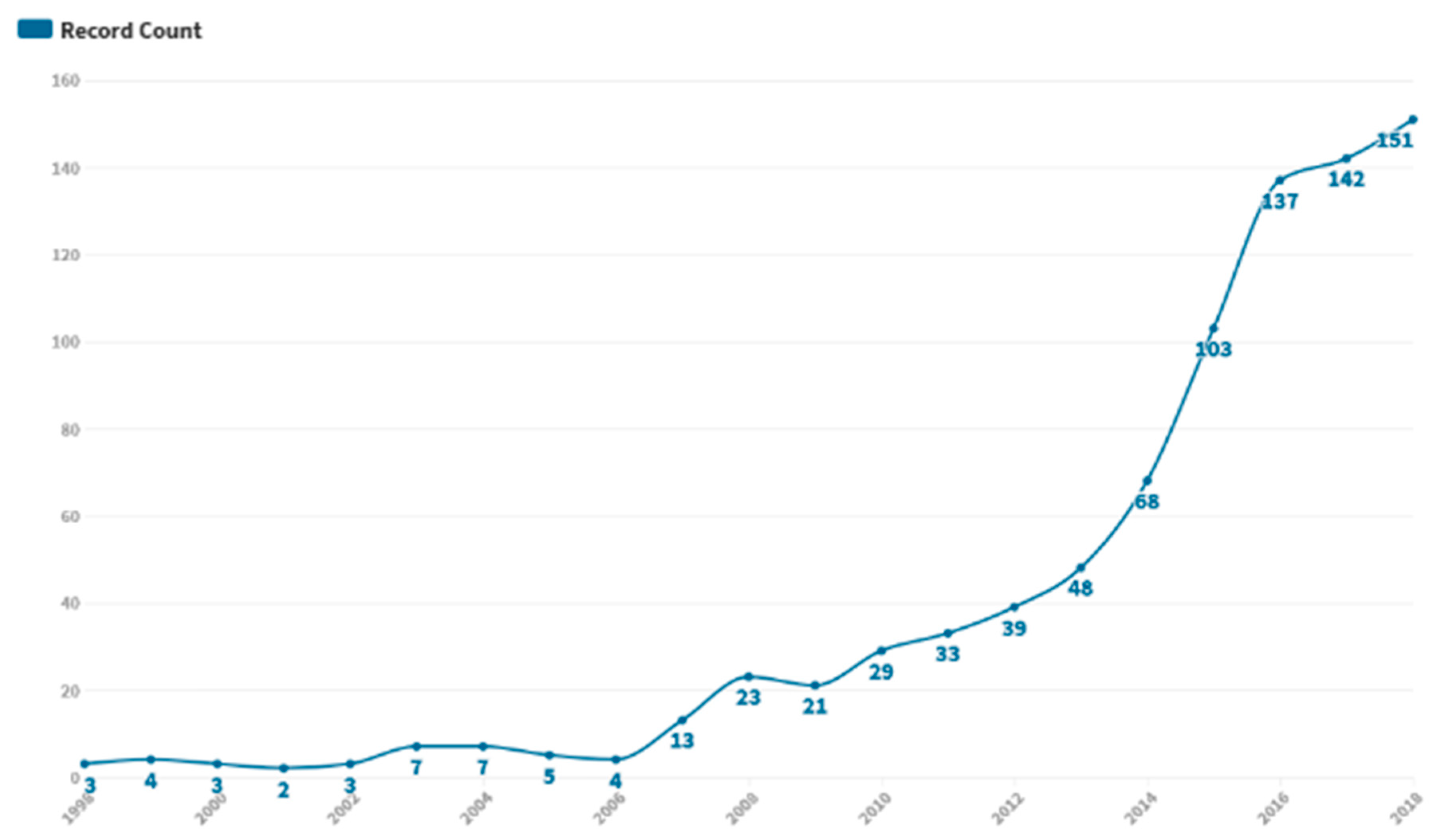
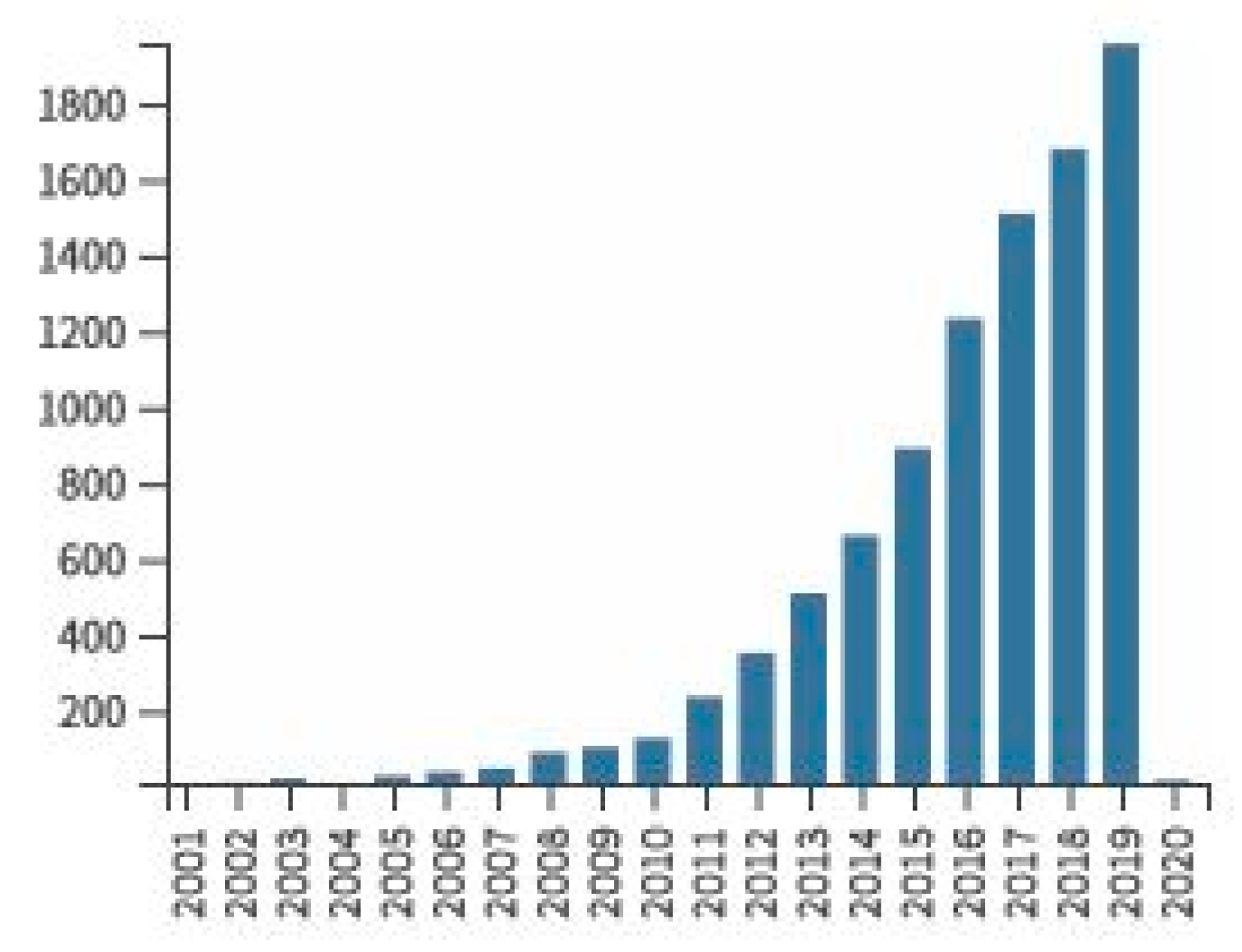
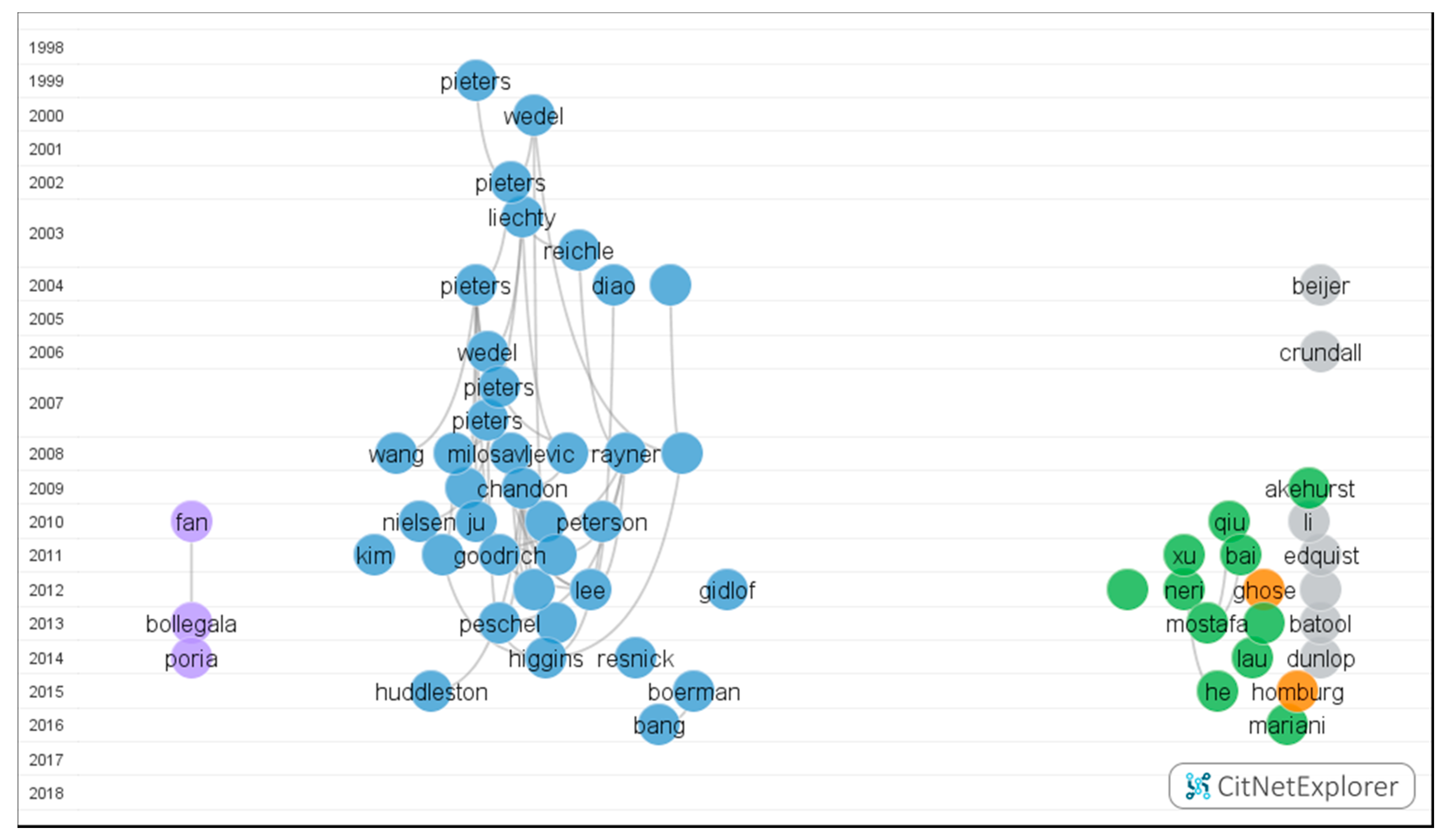
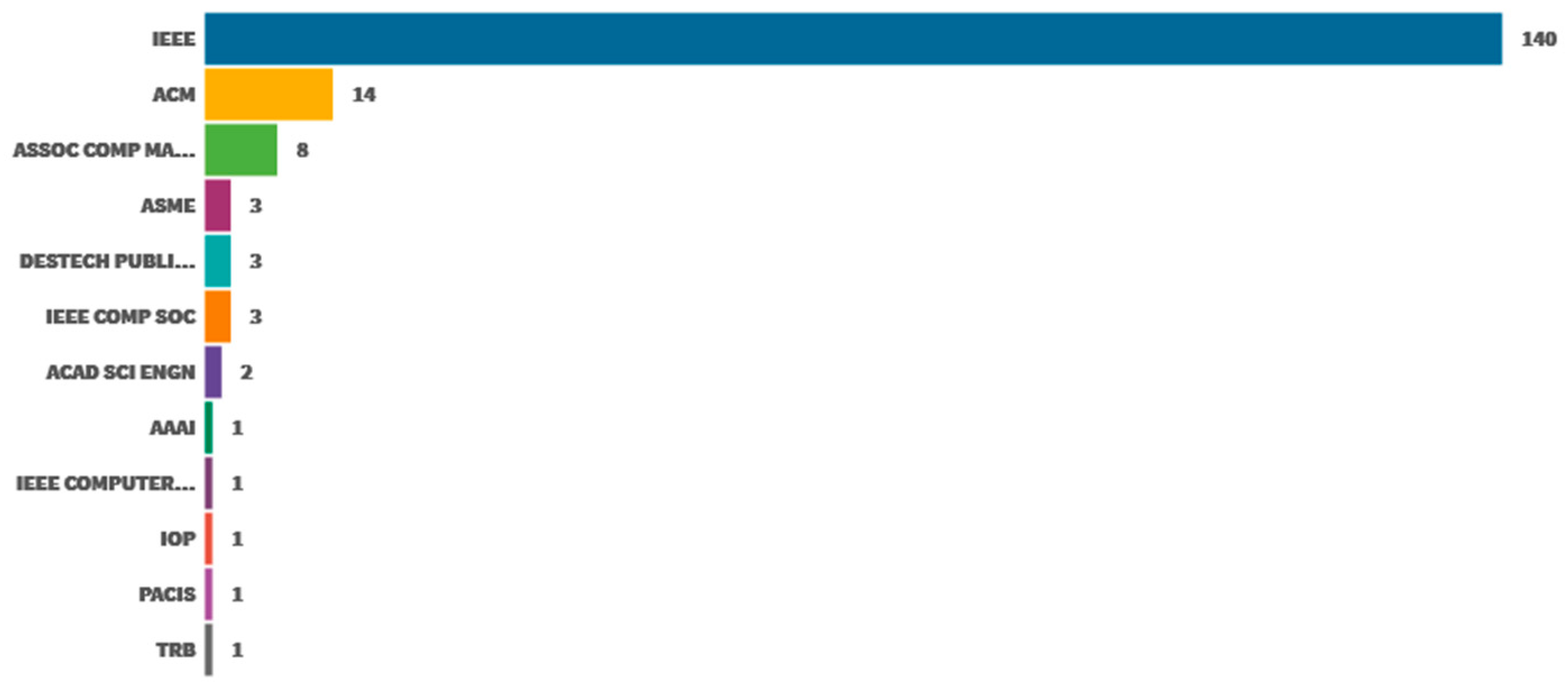
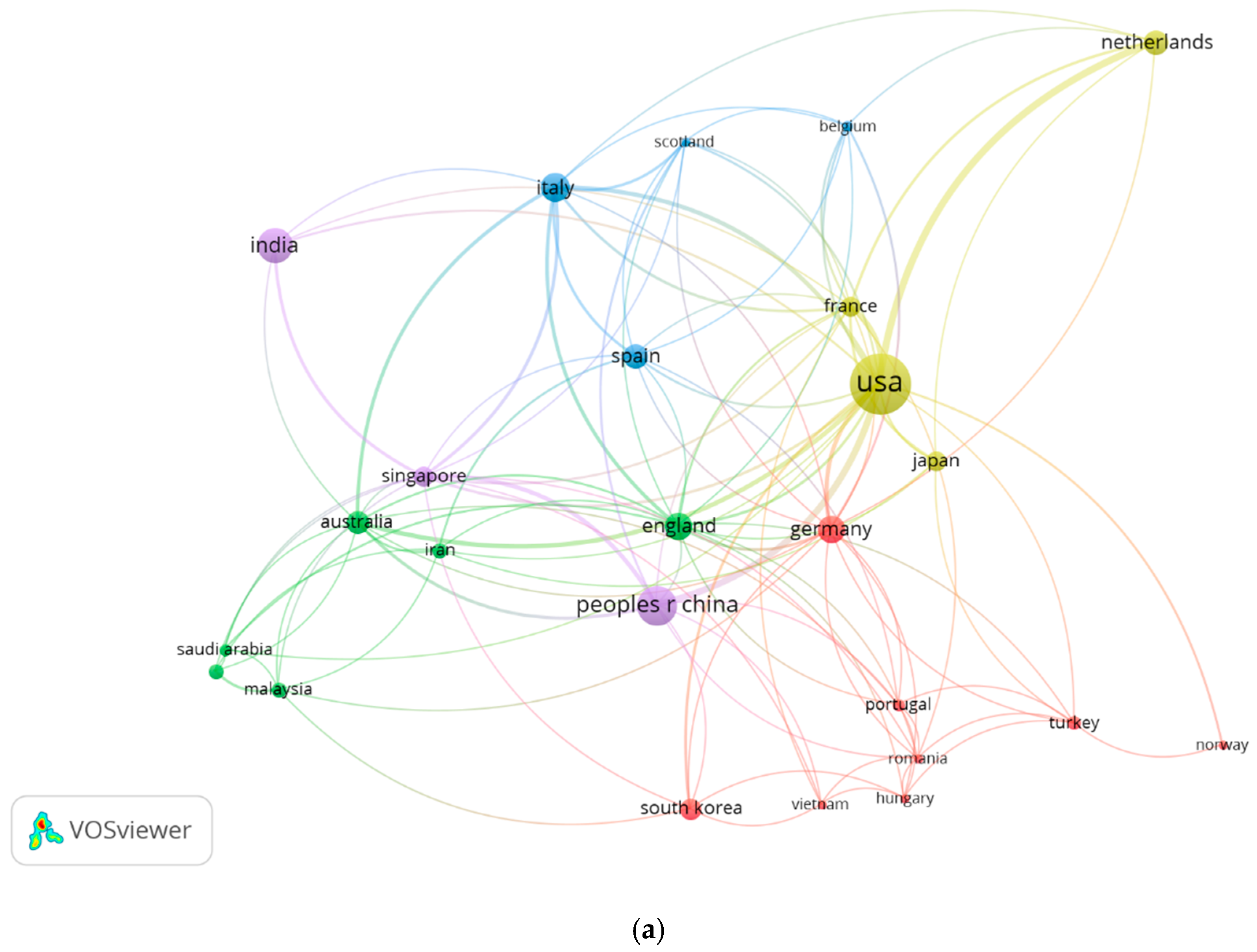
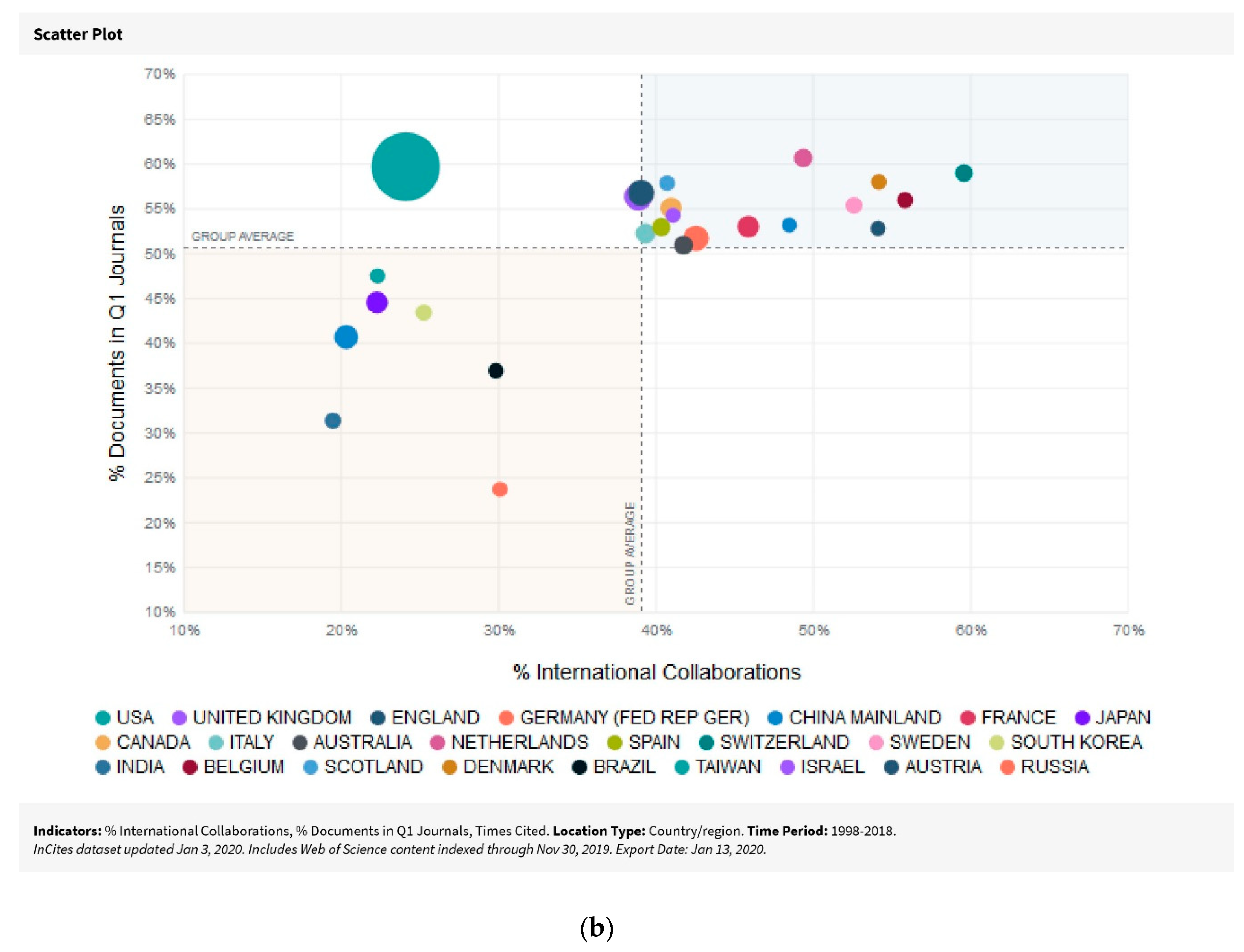

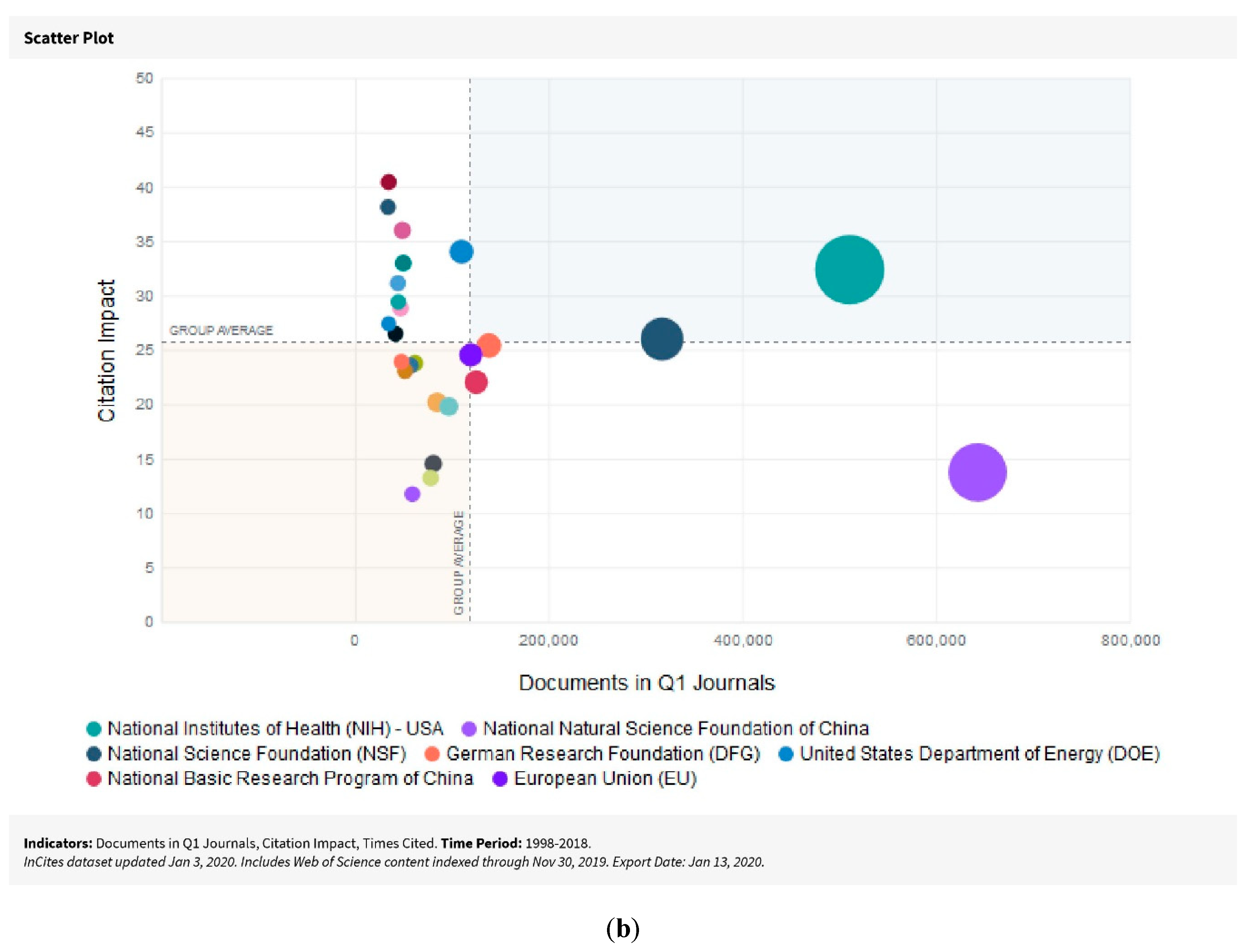
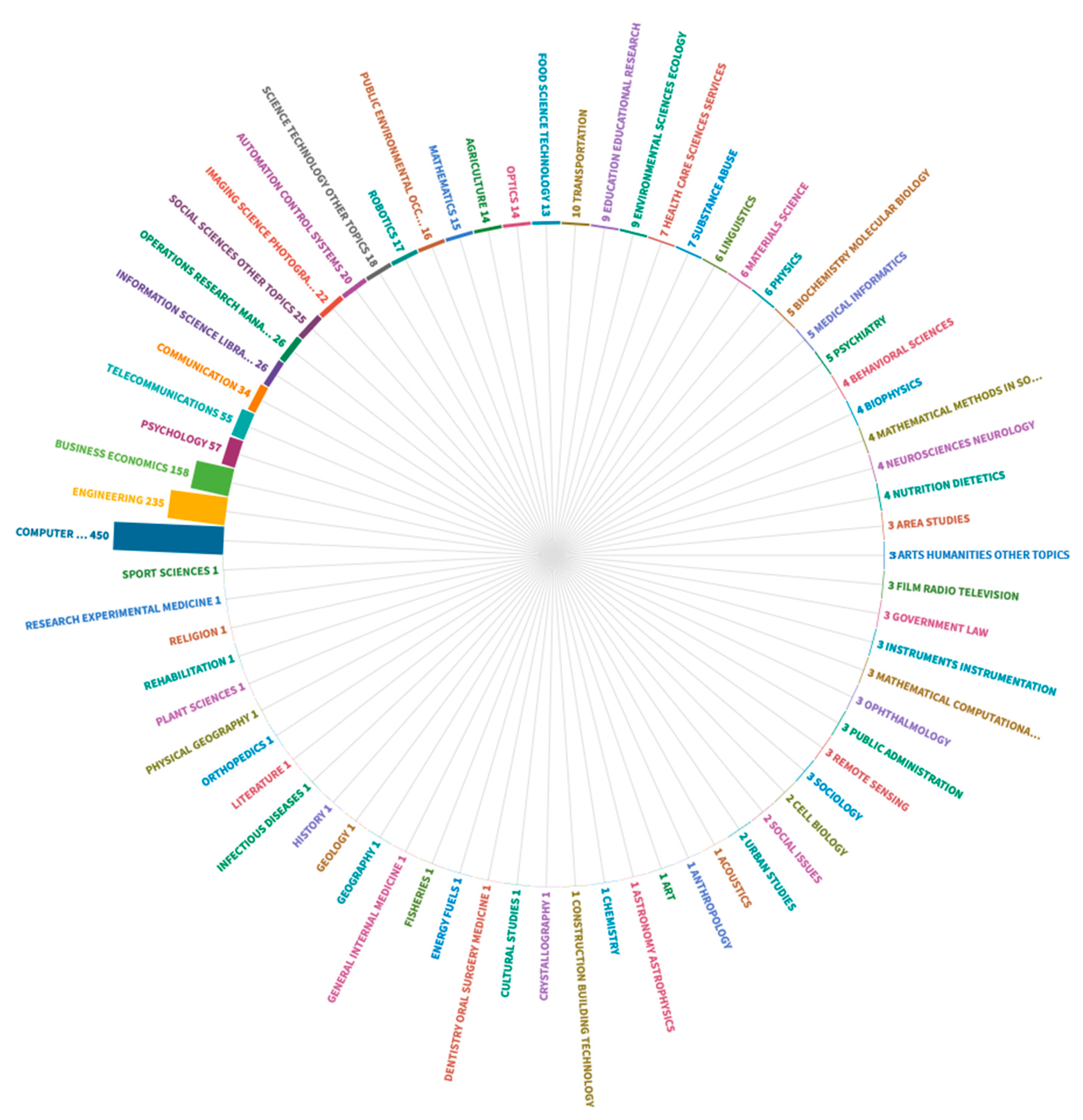
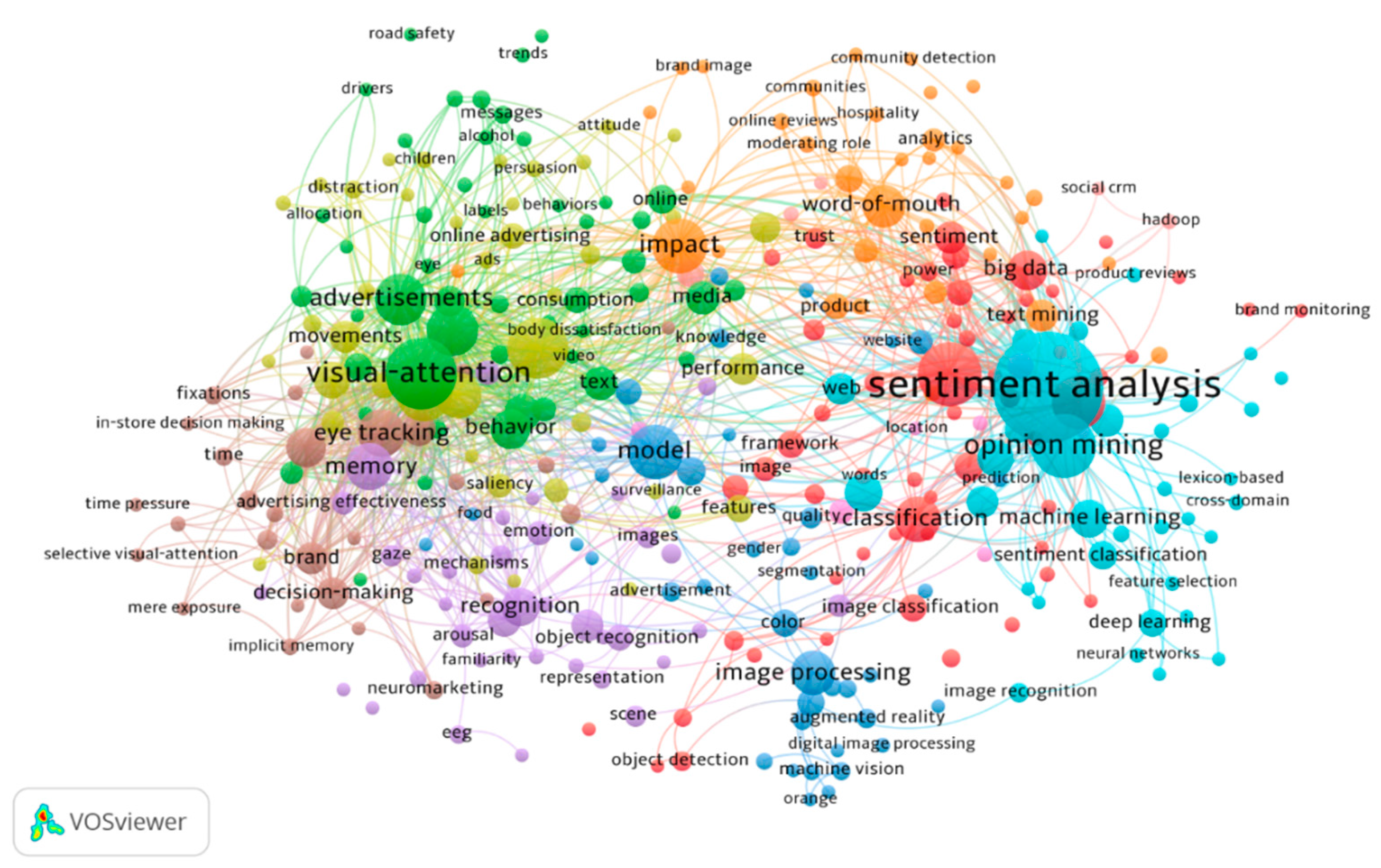
| Citation Report | |
|---|---|
| Total publications | 845 |
| Sum of times cited | 9557 |
| Average citations per item | 11.31 |
| H-index | 49 |
| Ranking | Author | Documents | Citations | Total Link Strength |
|---|---|---|---|---|
| 1. | Pieters, R | 6 | 775 | 6 |
| 2. | Wedel, M | 6 | 775 | 6 |
| 3. | Cambria, Erik | 8 | 306 | 4 |
| 4. | Wedel, Michel | 8 | 292 | 6 |
| 5. | Pieters, Rik | 6 | 288 | 6 |
| 6. | Poria, Soujanya | 3 | 205 | 3 |
| 7. | Wojdynski, Bartosz W. | 4 | 123 | 3 |
| 8. | Bang, Hyejin | 3 | 35 | 3 |
| 9. | Bodendorf, Freimut | 4 | 31 | 3 |
| 10. | Kaiser, Carolin | 3 | 31 | 3 |
| 11. | Holmberg, Nils | 3 | 18 | 3 |
| 12. | Sandberg, Helena | 3 | 18 | 3 |
| 13. | Recupero, Diego Reforgiato | 3 | 10 | 2 |
| 14. | Dragoni, Mauro | 4 | 7 | 1 |
| 15. | Farkas, Richard | 3 | 5 | 3 |
| 16. | Hangya, Viktor | 3 | 5 | 3 |
| 17. | Oliveira, Eugenio | 3 | 5 | 9 |
| 18. | Reis, Luis Paulo | 3 | 5 | 9 |
| 19. | Teixeira, Jorge | 3 | 5 | 9 |
| 20. | Vinhas, Vasco | 3 | 5 | 9 |
| 21. | Lu, Hanqing | 3 | 4 | 1 |
| 22. | Xu, Changsheng | 3 | 4 | 1 |
| 23. | Kincl, Tomas | 3 | 2 | 6 |
| 24. | Novak, Michal | 4 | 2 | 6 |
| 25. | Pribil, Jiri | 3 | 2 | 6 |
| Ranking | Organization | Documents | Citations | Total Link Strength | ARWU 2019 | QS 2019 |
|---|---|---|---|---|---|---|
| 1. | Tilburg University | 14 | 1085 | 14 | 501–600 | 319 |
| 2. | University of Michigan | 7 | 739 | 8 | 20 | 20 |
| 3. | University of Pennsylvania | 5 | 461 | 1 | 17 | 19 |
| 4. | The University of Maryland | 12 | 372 | 9 | 46 | 126 |
| 5. | Nanyang Technological University | 10 | 302 | 3 | 73 | 12 |
| 6. | City University of Hong Kong | 7 | 286 | 2 | 201–300 | 55 |
| 7. | Copenhagen Business School | 5 | 193 | 0 | 701–800 | - |
| 8. | University of Nottingham | 7 | 158 | 0 | 101–150 | 82 |
| 9. | University of California San Diego | 7 | 151 | 5 | 18 | 41 |
| 10. | The University of Georgia | 9 | 150 | 6 | 201–300 | 431 |
| 11. | Michigan State University | 6 | 138 | 5 | 101–150 | 141 |
| 12. | Pennsylvania State University | 6 | 129 | 7 | 98 | 95 |
| 13. | The University of Arizona | 6 | 100 | 4 | 101–150 | 246 |
| 14. | Korea Advanced Institute of Science and Technology | 5 | 85 | 1 | 201–300 | 40 |
| 15. | University of Amsterdam | 5 | 74 | 0 | 101–150 | 57 |
| 16. | University of Florida | 8 | 58 | 5 | 95 | 180 |
| 17. | University of Minnesota | 5 | 48 | 5 | 41 | 156 |
| 18. | Microsoft Research Asia | 5 | 42 | 1 | - | - |
| 19. | University of Pittsburgh | 6 | 39 | 1 | 89 | 136 |
| 20. | The Australian National University | 6 | 34 | 5 | 76 | 24 |
| 21. | Zhejiang University | 5 | 34 | 1 | 70 | 68 |
| 22. | University of Malaya | 5 | 22 | 1 | 301–400 | 87 |
| 23. | National University of Singapore | 7 | 19 | 3 | 67 | 11 |
| 24. | Chinese Academy of Sciences | 8 | 18 | 2 | - | - |
| 25. | Politecnico di Milano | 5 | 17 | 1 | 201–300 | 156 |
| Ranking | Source | Citations | Total Link Strength |
|---|---|---|---|
| 1. | Journal of Consumer Research | 521 | 10,340 |
| 2. | Journal of Marketing Research | 371 | 9258 |
| 3. | Journal of Marketing | 316 | 7353 |
| 4. | Lecture Notes in Computer Science LNCS | 296 | 1707 |
| 5. | Journal of Advertising | 279 | 5370 |
| 6. | Journal of Advertising Research | 276 | 6244 |
| 7. | IEEE Transactions on Pattern Analysis and Machine Intelligence | 249 | 1748 |
| 8. | Expert Systems with Applications | 246 | 6128 |
| 9. | Marketing Science | 239 | 7223 |
| 10. | Decision Support Systems | 213 | 5198 |
| 11. | IEEE Conference on Computer Vision and Pattern Recognition | 161 | 1015 |
| 12. | Management Science | 155 | 5277 |
| 13. | Journal of Interactive Marketing | 138 | 3716 |
| 14. | Psychology & Marketing | 138 | 3651 |
| 15. | Psychological Bulletin | 135 | 2116 |
| 16. | Vision Research | 125 | 1835 |
| 17. | Journal of Personality and Social Psychology | 121 | 2377 |
| 18. | Computers in Human Behavior | 120 | 2656 |
| 19. | Journal of Business Research | 114 | 4262 |
| 20. | Journal of the Association for Information Science and Technology | 112 | 880 |
| 21. | International Journal of Research in Marketing | 101 | 2990 |
| 22. | Psychological Review | 100 | 1739 |
| 23. | Advances in Consumer Research | 92 | 2420 |
| 24. | Journal of Experimental Psychology: Human Perception and Performance | 92 | 1731 |
| 25. | Tourism Management | 92 | 1592 |
| Title | Authors | Source | Publication Years | Citations | Average Citation/Year |
|---|---|---|---|---|---|
| 1. In the Eye of the Beholder: A Survey of Models for Eyes and Gaze | Hansen, Dan Witzner; Ji, Qiang | IEEE TRANSACTIONS ON PATTERN ANALYSIS AND MACHINE INTELLIGENCE | 2010 | 565 | 56.5 |
| 2. Attention capture and transfer in advertising: Brand, pictorial, and text-size effects | Pieters, R; Wedel, M | JOURNAL OF MARKETING | 2004 | 304 | 19 |
| 3. Does In-Store Marketing Work? Effects of the Number and Position of Shelf Facings on Brand Attention and Evaluation at the Point of Purchase | Chandon, Pierre; Hutchinson, J. Wesley; Bradlow, Eric T.; Young, Scott H. | JOURNAL OF MARKETING | 2009 | 249 | 22.64 |
| 4. More than words: Social networks’ text mining for consumer brand sentiments | Mostafa, Mohamed M. | EXPERT SYSTEMS WITH APPLICATIONS | 2013 | 188 | 26.86 |
| 5. Designing Ranking Systems for Hotels on Travel Search Engines by Mining User-Generated and Crowdsourced Content | Ghose, Anindya; Ipeirotis, Panagiotis G.; Li, Beibei | MARKETING SCIENCE | 2012 | 177 | 22.13 |
| 6. Eye fixations on advertisements and memory for brands: A model and findings | Wedel, M; Pieters, R | MARKETING SCIENCE | 2000 | 173 | 8.65 |
| 7. User generated content: the use of blogs for tourism organisations and tourism consumers | Akehurst, Gary | SERVICE BUSINESS | 2009 | 168 | 15.27 |
| 8. Breaking through the clutter: Benefits of advertisement originality and familiarity for brand attention and memory | Pieters, R; Warlop, L; Wedel, M | MANAGEMENT SCIENCE | 2002 | 143 | 7.94 |
| 9. Understanding Transit Scenes: A Survey on Human Behavior-Recognition Algorithms | Candamo, Joshua; Shreve, Matthew; Goldgof, Dmitry B.; Sapper, Deborah B.; Kasturi, Rangachar | IEEE TRANSACTIONS ON INTELLIGENT TRANSPORTATION SYSTEMS | 2010 | 140 | 14 |
| 10. Shape Analysis of Agricultural Products: A Review of Recent Research Advances and Potential Application to Computer Vision | Costa, Corrado; Antonucci, Francesca; Pallottino, Federico; Aguzzi, Jacopo; Sun, Da-Wen; Menesatti, Paolo | FOOD AND BIOPROCESS TECHNOLOGY | 2011 | 139 | 15.44 |
| 11. Sentic patterns: Dependency-based rules for concept-level sentiment analysis | Poria, Soujanya; Cambria, Erik; Winterstein, Gregoire; Huang, Guang-Bin | KNOWLEDGE-BASED SYSTEMS | 2014 | 132 | 22 |
| 12. Using Twitter to Examine Smoking Behavior and Perceptions of Emerging Tobacco Products | Myslin, Mark; Zhu, Shu-Hong; Chapman, Wendy; Conway, Mike | JOURNAL OF MEDICAL INTERNET RESEARCH | 2013 | 125 | 17.86 |
| 13. Branding the brain: A critical review and outlook | Plassmann, Hilke; Ramsoy, Thomas Zoega; Milosavljevic, Milica | JOURNAL OF CONSUMER PSYCHOLOGY | 2012 | 121 | 15.13 |
| 14. The impact of social and conventional media on firm equity value: A sentiment analysis approach | Yu, Yang; Duan, Wenjing; Cao, Qing | DECISION SUPPORT SYSTEMS | 2013 | 118 | 16.86 |
| 15. Survey on mining subjective data on the web | Tsytsarau, Mikalai; Palpanas, Themis | DATA MINING AND KNOWLEDGE DISCOVERY | 2012 | 118 | 14.75 |
| 16. A flexible model of consumer country-of-origin perceptions - A cross-cultural investigation | Knight, GA; Calantone, RJ | INTERNATIONAL MARKETING REVIEW | 2000 | 116 | 5.8 |
| 17. Affective News: The Automated Coding of Sentiment in Political Texts | Young, Lori; Soroka, Stuart | POLITICAL COMMUNICATION | 2012 | 113 | 14.13 |
| 18. Mining comparative opinions from customer reviews for Competitive Intelligence | Xu, Kaiquan; Liao, Stephen Shaoyi; Li, Jiexun; Song, Yuxia | DECISION SUPPORT SYSTEMS | 2011 | 113 | 12.56 |
| 19. Visual attention to repeated print advertising: A test of scanpath theory | Pieters, R; Rosbergen, E; Wedel, M | JOURNAL OF MARKETING RESEARCH | 1999 | 103 | 4.9 |
| 20. Building models for marketing decisions: Past, present and future | Leeflang, PSH; Wittink, DR | INTERNATIONAL JOURNAL OF RESEARCH IN MARKETING | 2000 | 92 | 4.6 |
| 21. Goal control of attention to advertising: The Yarbus implication | Pieters, Rik; Wedel, Michel | JOURNAL OF CONSUMER RESEARCH | 2007 | 90 | 6.92 |
| 22. What Do You See When You’re Surfing? Using Eye Tracking to Predict Salient Regions of Web Pages | Buscher, Georg; Cutrell, Edward; Morris, Meredith Ringel | CHI2009: PROCEEDINGS OF THE 27TH ANNUAL CHI CONFERENCE ON HUMAN FACTORS IN COMPUTING SYSTEMS, VOLS 1–4 | 2009 | 89 | 8.09 |
| 23. Going Native: Effects of Disclosure Position and Language on the Recognition and Evaluation of Online Native Advertising | Wojdynski, Bartosz W.; Evans, Nathaniel J. | JOURNAL OF ADVERTISING | 2016 | 88 | 22 |
| 24. H-ATLAS: PACS imaging for the Science Demonstration Phase | Ibar, Edo; Ivison, R. J.; Cava, A.; Rodighiero, G.; Buttiglione, S.; Temi, P.; Frayer, D.; Fritz, J.; Leeuw, L.; Baes, M.; Rigby, E.; Verma, A.; Serjeant, S.; Mueller, T.; Auld, R.; Dariush, A.; Dunne, L.; Eales, S.; Maddox, S.; Panuzzo, P.; Pascale, E.; Pohlen, M.; Smith, D.; de Zotti, G.; Vaccari, M.; Hopwood, R.; Cooray, A.; Burgarella, D.; Jarvis, M. | MONTHLY NOTICES OF THE ROYAL ASTRONOMICAL SOCIETY | 2010 | 87 | 8.7 |
| 25. Predicting consumer sentiments from online text | Bai, Xue | DECISION SUPPORT SYSTEMS | 2011 | 85 | 9.44 |
| Indexes | Timespan | Search | Results | Date |
|---|---|---|---|---|
| Web of Science Core Collection: SCI-EXPANDED, SSCI, A&HCI, CPCI-S, CPCISSH, BKCI-S, BKCI-SSH, ESCI. | 1998–2018 | ((((((TS = (((“Sentiment Analysis”) OR (“Sentiment of Images”) OR (“Sentiment Classification”) OR (“Opinion Mining”) OR (“Opinion Classification”) OR (“Image Sentiment”) OR (“Image Emotion”) OR (“Image Processing”) OR (“Image Recognition”) OR (“Mining sentiment”) OR (“Visual Content”) OR (“Visual Attention”) OR (“Object Recognition”) OR (“Object Detection”) OR (“Image Classification”) OR (“Affect Analysis”) OR (“Affective Computing”)) AND (Advert* OR “Marketing”)))))))) AND LANGUAGES: (English) AND DOCUMENT TYPES: (Article OR Book Chapter OR Proceedings Paper OR Review) | 845 | 03.12.2019 |
© 2020 by the authors. Licensee MDPI, Basel, Switzerland. This article is an open access article distributed under the terms and conditions of the Creative Commons Attribution (CC BY) license (http://creativecommons.org/licenses/by/4.0/).
Share and Cite
Sánchez-Núñez, P.; de las Heras-Pedrosa, C.; Peláez, J.I. Opinion Mining and Sentiment Analysis in Marketing Communications: A Science Mapping Analysis in Web of Science (1998–2018). Soc. Sci. 2020, 9, 23. https://doi.org/10.3390/socsci9030023
Sánchez-Núñez P, de las Heras-Pedrosa C, Peláez JI. Opinion Mining and Sentiment Analysis in Marketing Communications: A Science Mapping Analysis in Web of Science (1998–2018). Social Sciences. 2020; 9(3):23. https://doi.org/10.3390/socsci9030023
Chicago/Turabian StyleSánchez-Núñez, Pablo, Carlos de las Heras-Pedrosa, and José Ignacio Peláez. 2020. "Opinion Mining and Sentiment Analysis in Marketing Communications: A Science Mapping Analysis in Web of Science (1998–2018)" Social Sciences 9, no. 3: 23. https://doi.org/10.3390/socsci9030023
APA StyleSánchez-Núñez, P., de las Heras-Pedrosa, C., & Peláez, J. I. (2020). Opinion Mining and Sentiment Analysis in Marketing Communications: A Science Mapping Analysis in Web of Science (1998–2018). Social Sciences, 9(3), 23. https://doi.org/10.3390/socsci9030023







